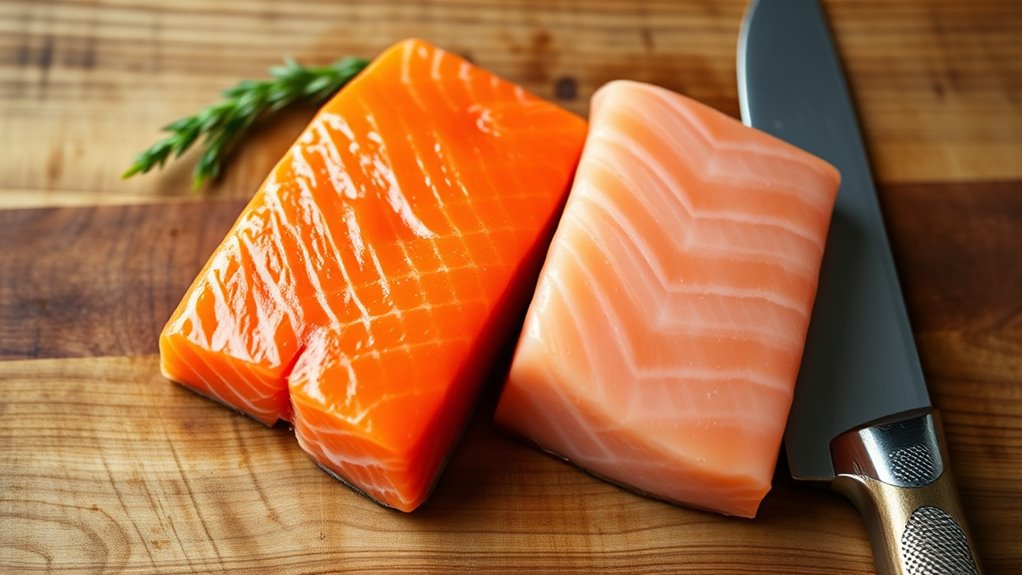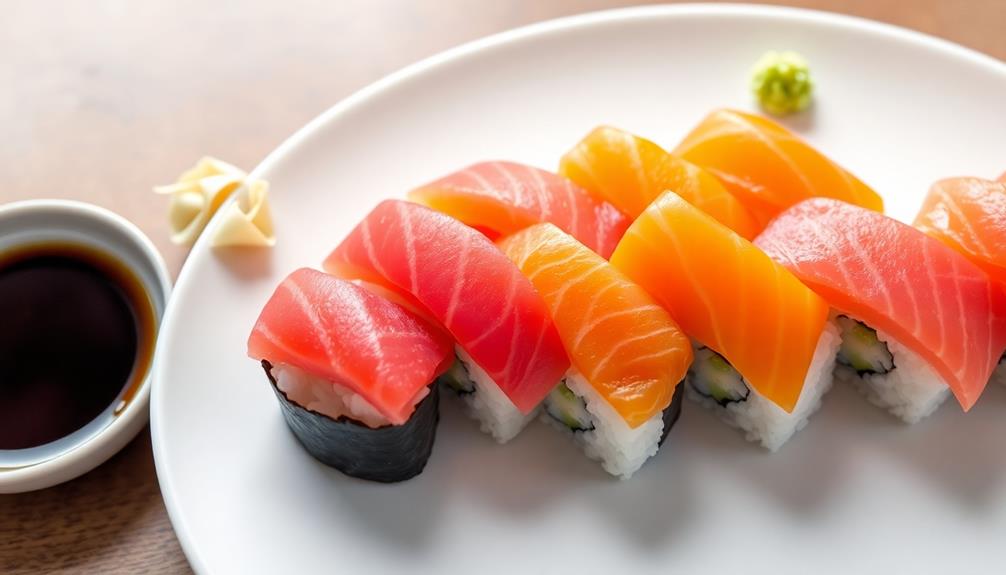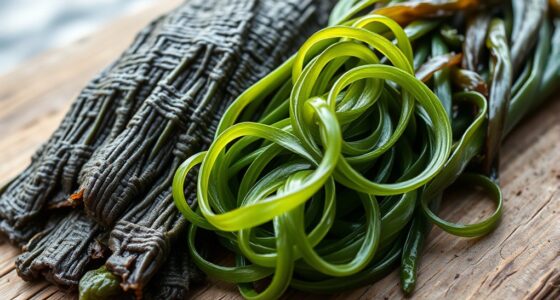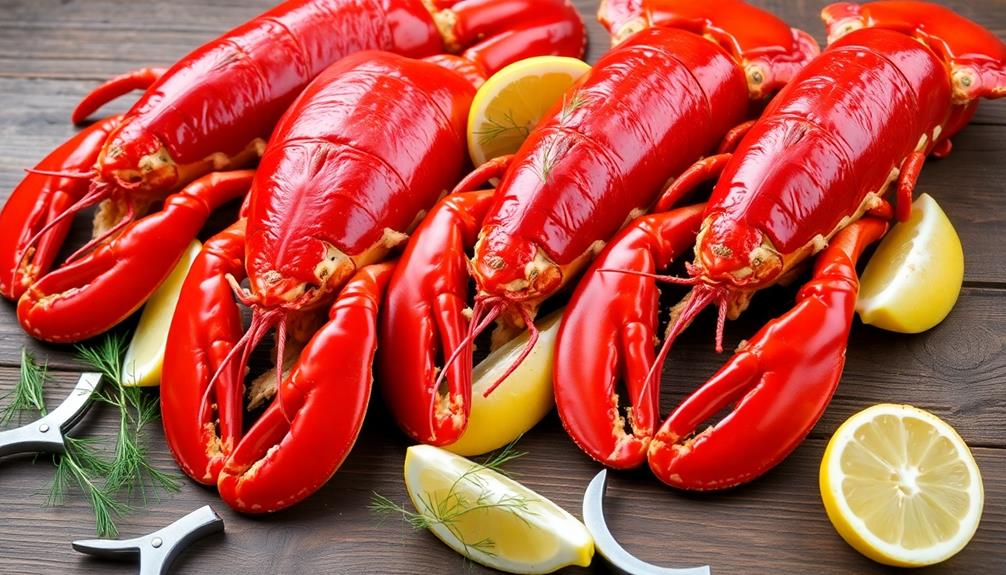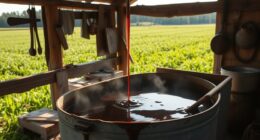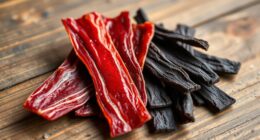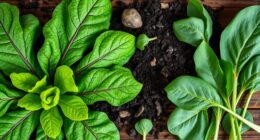When cooking wild-caught salmon, you’ll find it can lose more omega-3s if overcooked because it’s leaner and dries out faster. Farm-raised salmon’s higher fat content helps retain omega-3s better during various cooking methods. To maximize nutrients, aim for gentle methods like steaming or poaching. Knowing these differences helps you cook smarter—if you want to learn more about preserving omega-3s in both types, keep exploring how techniques can make a difference.
Key Takeaways
- Farm-raised salmon generally retains more omega-3s due to higher fat content during cooking.
- Overcooking wild salmon causes greater omega-3 and flavor loss because of its leaner flesh.
- Gentle cooking methods like steaming preserve omega-3s better than high-heat techniques like grilling.
- Proper timing and temperature control are crucial for maximizing omega-3 retention in both salmon types.
- Wild salmon’s leaner profile requires careful cooking to prevent nutrient loss, while farmed salmon is more forgiving.

Have you ever wondered whether wild-caught or farm-raised salmon is the better choice for your plate? When it comes to cooking and preserving omega-3s, the type of salmon you choose can make a notable difference. One key aspect many people overlook is how cooking methods affect omega-3 retention, especially considering the differences between wild and farmed salmon. These distinctions are essential because they influence not only health benefits but also your overall dining experience.
Choosing wild or farmed salmon impacts omega-3 retention and your overall dining experience.
Sustainability concerns often sway your decision between wild and farmed options. Wild salmon is generally seen as more environmentally friendly because it relies on natural ecosystems and has less impact from farming practices. However, wild populations face threats from overfishing and habitat degradation, which can raise questions about long-term sustainability. On the other hand, farm-raised salmon offers a more controlled environment, potentially reducing pressure on wild stocks, but it comes with its own environmental issues, such as water pollution and feed sustainability. These factors don’t just influence your choice based on ethics but also affect the quality and flavor of the fish.
Flavor differences are another important consideration. Wild salmon typically has a more intense, complex flavor profile, often described as richer and more nuanced. Farm-raised salmon, by contrast, tends to be milder and fattier, which some people prefer for its consistency. When cooking, these flavor profiles respond differently to heat. Wild salmon’s leaner flesh may dry out more quickly if overcooked, leading to a loss of omega-3s and flavor. Farmed salmon’s higher fat content can make it more forgiving during cooking, helping it stay moist and retain more omega-3 fatty acids even with slightly longer cooking times.
Cooking methods play a significant role in how well omega-3s are preserved. Gentle methods like poaching or steaming tend to retain more nutrients, regardless of salmon type. Searing or grilling can cause some omega-3s to break down, especially if the heat is too high or applied for too long. Fascinatingly, because farmed salmon is fattier, it often holds onto omega-3s better during cooking, but wild salmon’s leaner nature means you need to be more careful not to overcook. To maximize omega-3 retention, aim for cooking just until the fish is opaque and flakes easily—this approach preserves those valuable fatty acids. Additionally, understanding the composition of omega-3s in both types can help you choose the best cooking methods for maximum health benefits.
Frequently Asked Questions
Which Salmon Type Has a Richer Flavor Profile?
You’ll find that wild salmon generally has a richer flavor profile, with more pronounced taste nuances and a stronger flavor intensity. This is because wild salmon feeds on a diverse diet, giving it a deeper, more complex taste. Farm-raised salmon tends to have a milder, more uniform flavor. So, if you’re after a more robust, flavorful experience, wild salmon is your best choice for a richer taste profile.
Does Cooking Method Affect Omega-3 Retention Differently?
Cooking techniques considerably influence nutrient preservation, including omega-3 retention. You should choose gentle methods like steaming or poaching, which help retain more omega-3 fatty acids. High-heat techniques like grilling or frying can cause more nutrient loss. By selecting appropriate cooking methods, you guarantee you maximize omega-3 intake, maintaining the health benefits of your salmon while enjoying its flavor.
Are There Health Risks Associated With Farm-Raised Salmon?
Think of farm-raised salmon as a garden needing careful tending. While it offers omega-3 benefits, you should be aware of contaminant concerns and antibiotic use. These risks can vary by farm practices, so buy from reputable sources. Regularly consuming farm-raised salmon might expose you to higher levels of pollutants, but choosing certified options helps reduce health risks and supports safer, sustainable seafood choices.
How Does Salmon Freshness Impact Omega-3 Levels?
You’ll find that fresher salmon, whether frozen or fresh, retains higher omega-3 levels. Proper storage conditions are key—keep it cold and use it quickly. Frozen salmon, if stored properly, can be nearly as nutritious as fresh, but avoid long storage times. Always check for a shiny appearance and firm texture to verify freshness, which directly impacts omega-3 content and overall health benefits.
Is Wild-Caught Salmon More Sustainable Than Farm-Raised?
You might wonder if wild-caught salmon is more sustainable than farm-raised. Generally, wild-caught salmon has a lower environmental impact due to responsible aquaculture practices and natural population management. Farm-raised salmon can strain ecosystems if poorly managed, leading to issues like pollution and disease. By choosing wild-caught, you’re supporting sustainable fishing methods that minimize environmental impact, but always check for certifications to guarantee responsible sourcing.
Conclusion
So, whether you prefer wild‑caught or farm‑raised salmon, remember that cooking methods matter. While wild salmon often boasts higher omega‑3s, proper preparation can help preserve these healthy fats. Think of your cooking as a treasure map—each step leading to a delicious, nutritious bounty. By making mindful choices, you’re not just eating fish; you’re revealing nature’s secret to health. Immerse yourself with confidence and savor every omega‑rich bite!
